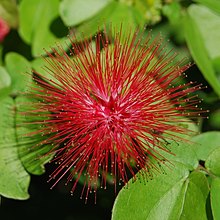Mimosoideae
| Mimosoideae | |
|---|---|

| |
| Calliandra emarginata | |
| Scientific classification | |
| Kingdom: | |
| (unranked): | |
| (unranked): | |
| (unranked): | |
| Order: | |
| Family: | |
| Subfamily: | Mimosoideae |
| Informal Groups | |
|
See text. | |

| |
| Distribution of the Mimosoideae. | |
| Synonyms | |
| |
The Mimosoideae comprise a subfamily of the flowering plant family Fabaceae (Leguminosae) characterized by flowers with small petals and numerous prominent stamens.
In some classifications (e.g. the Cronquist system), "Mimosoideae" refers to what was formerly considered the tribe Mimoseae.
Taxonomy

Some classification systems, for example the Cronquist system, treat the Fabaceae in a narrow sense, raising the Mimisoideae to the rank of family as Mimosaceae. The Angiosperm Phylogeny Group treats Fabaceae in the broad sense. The Mimosoideae were historically subdivided into four tribes (Acacieae, Ingeae, Mimoseae, and Mimozygantheae). However, modern molecular phylogenetics have shown that these groupings were artificial. Several informal subgroups have been proposed, but not yet described formally as tribes.[1][2][3][4] Additionally, the genus Acacia was recently segregated into five genera (Acacia sensu lato, Acaciella, Mariosousa, Senegalia, and Vachellia).[5]
- Abarema Group[6]
- Abarema Pittier
- Balizia Barneby & J.W.Grimes
- Hydrochorea Barneby & J.W.Grimes
- Adenanthera Group
- Adenanthera L.
- Amblygonocarpus Harms
- Calpocalyx Harms
- Pseudoprosopis Harms
- Tetrapleura Benth.
- Xylia Benth.
- Chloroleucon Group
- Blanchetiodendron Barneby & J.W.Grimes
- Cathormion (Benth.) Hassk.
- Chloroleucon (Benth.) Britton & Rose
- Leucochloron Barneby & J.W.Grimes
- Thailentadopsis Kosterm.
- Dichrostachys Group
- Alantsilodendron Villiers
- Calliandropsis H.M.Hern. & P.Guinet
- Dichrostachys (DC.) Wight & Arn.
- Gagnebina Neck. ex DC.
- Entada Group
- Elephantorrhiza Benth.
- Entada Adans.
- Inga Group
- Archidendron F.Muell.
- Calliandra Benth.
- Cedrelinga Ducke
- Cojoba Britton & Rose
- Guinetia L.Rico & M.Sousa
- Inga Mill.
- Macrosamanea Britton & Rose
- Marmaroxylon Killip
- Pararchidendron I.C.Nielsen
- Viguieranthus Villiers
- Zygia P.Browne
- Leucaena Group
- Desmanthus Willd.
- Kanaloa Lorence & K.R.Wood
- Leucaena Benth.
- Schleinitzia Warb. ex Nevling & Niezgoda
- Newtonia Group
- Indopiptadenia Brenan
- Lemurodendron Villiers & P. Guinet
- Newtonia Baill.
- Old World Group
- Archidendropsis I.C.Nielsen
- Falcataria (I.C.Nielsen) Barneby & J.W.Grimes
- Paraserianthes I.C.Nielsen
- Serianthes Benth.
- Wallaceodendron Koord.
- Piptadenia Group
- Adenopodia C.Presl
- Anadenanthera Speg.
- Microlobius C.Presl
- Mimosa L.
- Parapiptadenia Brenan
- Parkia R.Br.
- Piptadenia Benth.
- Pseudopiptadenia Rauschert
- Stryphnodendron Mart.
- Pithecellobium Group
- Ebenopsis Britton & Rose
- Havardia Small
- Painteria Britton & Rose
- Pithecellobium Mart.
- Sphinga Barneby & J.W.Grimes
- Prosopis Group
- Mimozyganthus Burkart
- Neptunia Lour
- Piptadeniopsis Burkart
- Prosopidastrum Burkart
- Prosopis L.
- Xerocladia Harv.
- Samanea Group
- Hesperalbizia Barneby & J.W.Grimes
- Pseudosamanea Harms
- Samanea (DC.) Merr.
- Unassigned
- Acacia Mill.
- Acaciella Britton & Rose
- Albizia Durazz.
- Aubrevillea Pellegr.
- Cylicodiscus Harms
- Enterolobium Mart.
- Faidherbia A.Chev.
- Fillaeopsis Harms
- Lysiloma Benth.
- Mariosousa Seigler & Ebinger
- Pentaclethra Benth.
- Piptadeniastrum Brenan
- Pityrocarpa Britton & Rose
- Plathymenia Benth.
- Senegalia Raf.
- Vachellia Wight & Arn.
- Zapoteca H.M.Hern.
References
- ^ Polhill RM, Raven PH, eds. (1981). "Mimoseae". Advances in Legume Systematics, Parts 1 and 2. Royal Botanic Gardens, Kew. pp. 155–168. ISBN 9780855212247.
{{cite book}}: Unknown parameter|authors=ignored (help) - ^ Herendeen PS; Bruneau A. Pollard PS, eds. (2000). "Relationships among the basal genera of mimosoid legumes". Advances in Legume Systematics, Part 9. Royal Botanic Gardens, Kew. pp. 165–180. ISBN 9781842460177.
{{cite book}}: Unknown parameter|authors=ignored (help) - ^ Klitgaard BB, Bruneau A, eds. (2003). "A phylogenetic analysis of the Mimosoideae (Leguminosae) based on chloroplast DNA sequence data". Advances in Legume Systematics, Part 10: Higher Level Systematics. Royal Botanic Gardens, Kew. pp. 197–220. ISBN 9781842460542.
{{cite book}}: External link in|chapterurl=|authors=ignored (help); Unknown parameter|chapterurl=ignored (|chapter-url=suggested) (help) - ^ Klitgaard BB, Bruneau A, eds. (2003). "Relationships among genera of the informal Dichrostachys and Leucaena groups (Mimosoideae) inferred from ribosomal ITS sequences". Advances in Legume Systematics, Part 10: Higher Level Systematics. Royal Botanic Gardens, Kew. pp. 221–238. ISBN 9781842460542.
{{cite book}}: External link in|chapterurl=|authors=ignored (help); Unknown parameter|chapterurl=ignored (|chapter-url=suggested) (help) - ^ "Molecular phylogeny of Acacia Mill. (Mimosoideae: Leguminosae): Evidence for major clades and informal classification". Taxon. 59 (1): 7–19. 2010. JSTOR 27757046.
{{cite journal}}: Unknown parameter|authors=ignored (help) - ^ "A Preliminary Molecular Phylogeny of the Abarema Alliance (Leguminosae) and Implications for Taxonomic Rearrangement". International Journal of Plant Sciences. 177 (1): 34–43. 2016. doi:10.1086/684078.
{{cite journal}}: Unknown parameter|authors=ignored (help)
